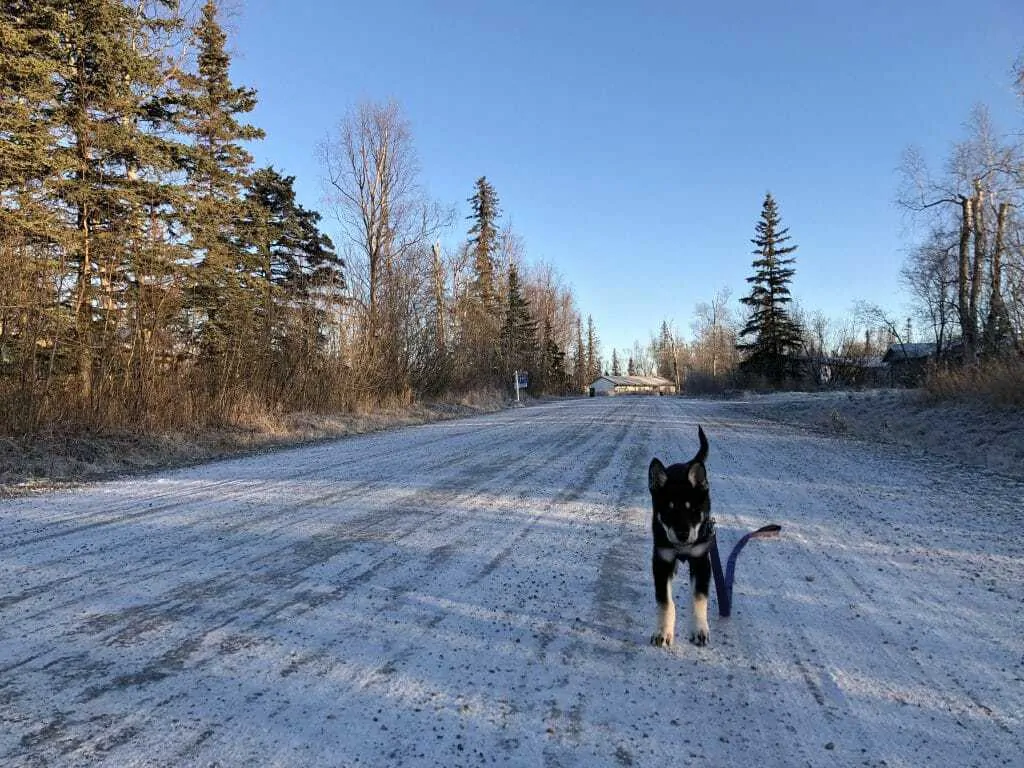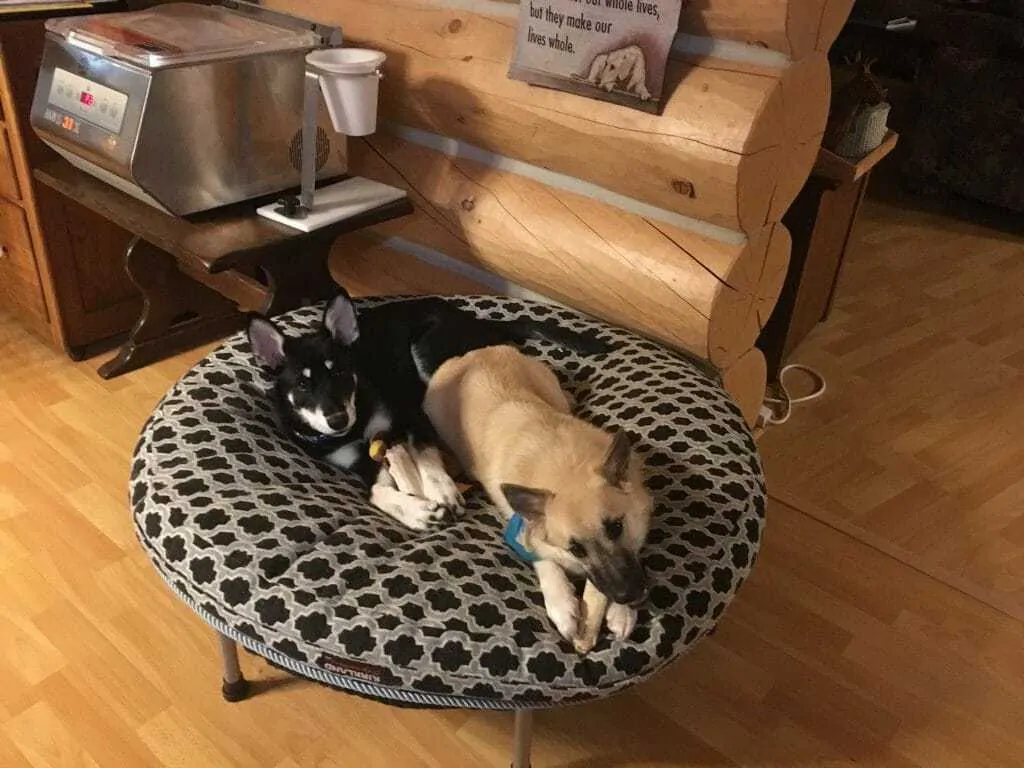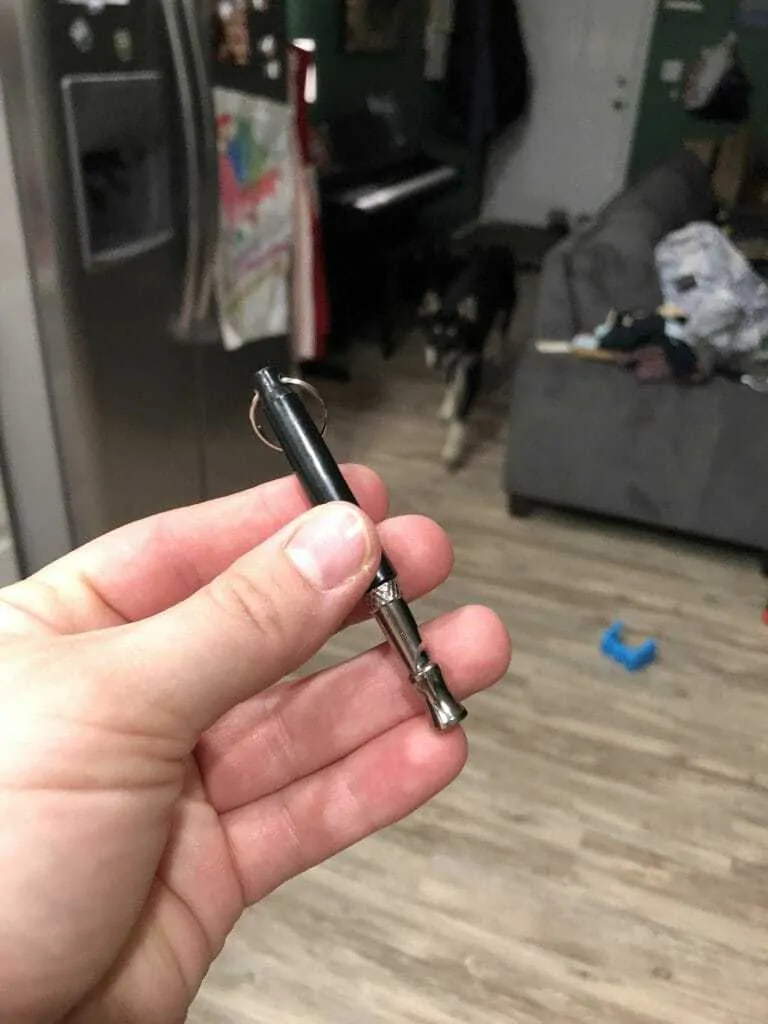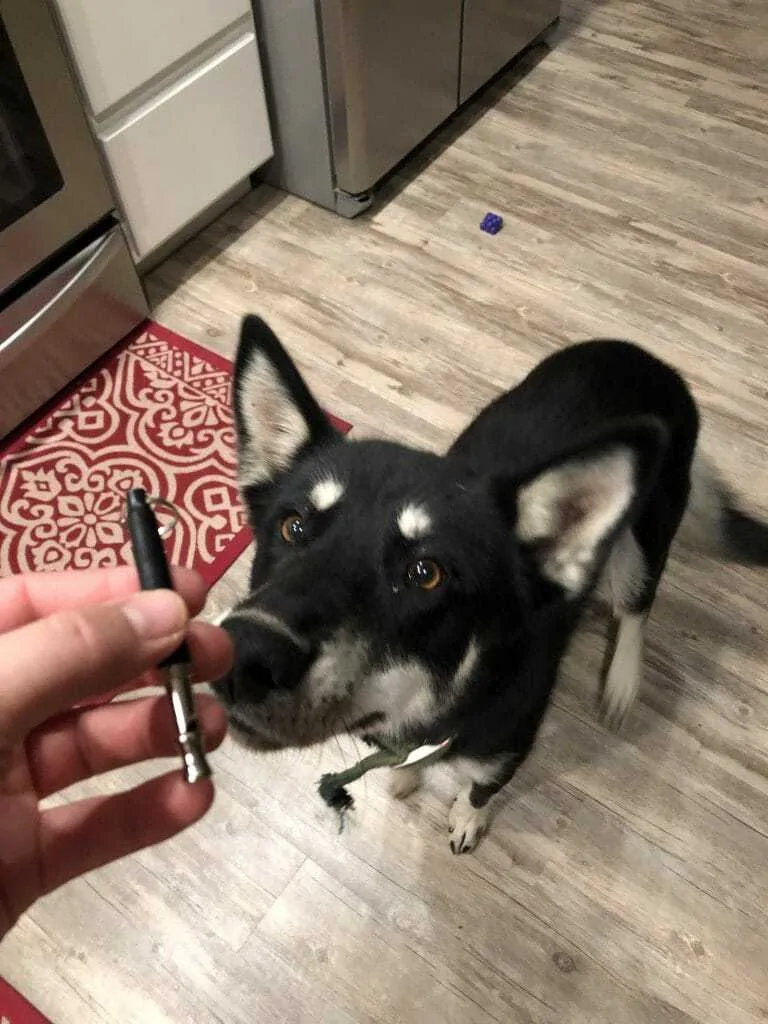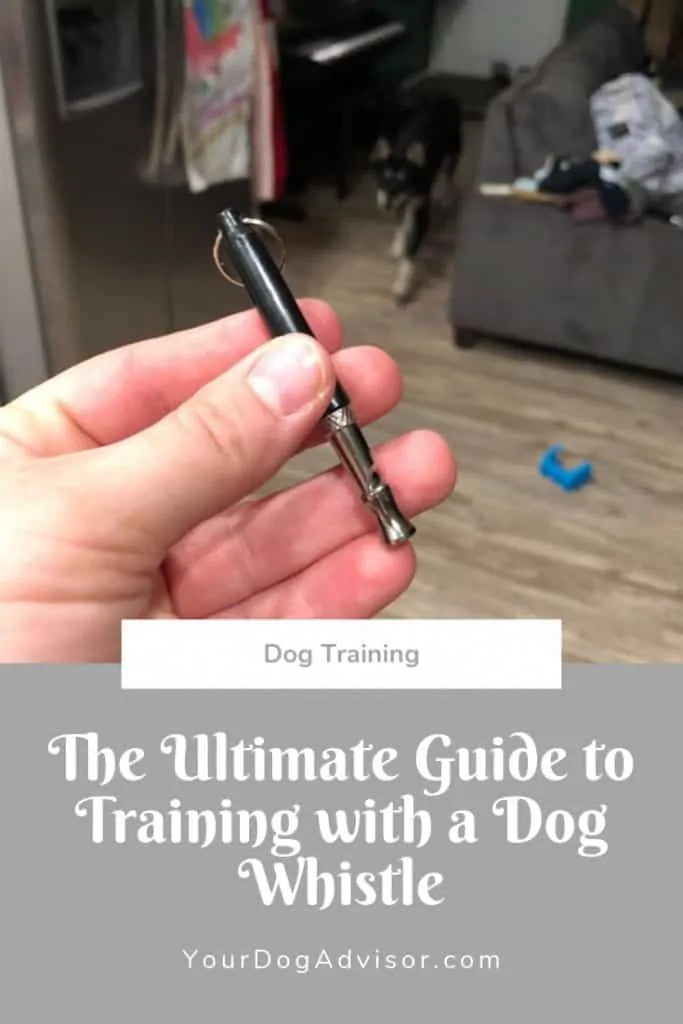When we first brought our Alaskan shepherd, Eira, home last November, I jumped into training her right away. She was sweet, cuddly, and extremely loud — a problem for my son with sensory processing special needs — so I figured I could train her early. It was essential to get her well trained before she grew big enough to jump on my son and knock him over (he’s three).
At first, I spent time training Eira every single night after my son went to bed. She picked up commands quickly: before long, she knew sit, down, stay, and even come. I could let go of her leash when we were still a ways from the house, ask her to stay, walk a ways in front of her, and then say “come!” and she’d come sprinting toward me.
Eira as a young puppy, sprinting toward me on a ‘come’ command. I was so proud!
She was well on her way to being a well-trained family dog.
And then, Christmastime came. Most Christmases, my family heads down to “the Lower 48,” AKA the United States mainland, to visit our extended family. That year, we would be gone for two weeks. Before we’d bought Eira from her breeder, we had set up plans with our neighbor. Our neighbor would keep Eira at her house and we would pay her a small fee to care for her for two weeks. The neighbor said she loved puppies and looked forward to caring for Eira. I left her detailed instructions, including notes on how Eira needed to play outside at least once a day to get her energy out.
Everything seemed wonderful. My toddler, husband, and I enjoyed the warm, relentless California sun — a treat after a largely lightless Alaska winter. But about three days after we’d left Eira with the neighbor, the texts started to come.
Eira was howling all night, keeping the neighbors awake. (I wholeheartedly believed this one.)
Eira had broken the husband’s glasses. (Believed this, too.)
Eira was jumping up on the counter and turning the stove on. (Not so sure about the veracity of this claim.)
To attempt to solve these problems, the neighbors had smacked her with rolled-up newspaper and put her in the submissive position — neither of which were things I approved of. I was angry that she’d done this to Eira.
In short, my neighbor was fed up and so was I. “I’m sorry,” she told me. “I can’t do this anymore.”
I agreed that Eira needed to go elsewhere. I knew that being smacked with newspaper and put on her back had probably made her nervous and even more behaviorally unsound.
She didn’t have her rabies shot yet so couldn’t go to a kennel. Thankfully, a friend who runs dogs in the Iditarod jumped in to help and brought Eira to her home for the rest of the two weeks. There was some howling, but after a while Eira grew comfortable there and enjoyed playing with the family’s other house dog.
Eira and at the Iditarod runner’s house with one of her dogs.
But when we got home for Christmas, the damage by our neighbors had been done. That, combined with our long absence, meant that Eira had forgotten a lot of her training.
Instead of coming when I called, Eira ran off through the snow and wouldn’t come back unless I coaxed her with giant hunks of burger. It became impossible to leave her off the leash — ever. (Unless she was inside of course!)
And if we’re honest, she never fully got her training back, although getting a Flexi leash helped a lot with being able to let her run somewhat freely and not run off.
Recently, after she got spayed, Eira even forgot her potty training and pooped on our carpet three different times in one week.
Needless to say, we were ready for a new round of training. And that’s where the whistle comes in.
Contents
What Is a Dog Whistle for Training?
A dog whistle for training is a special whistle designed for a dog’s ear. It can be loud, like a whistle teachers use to bring their students in from recess. Or it can be a silent whistle, which is quiet to humans and loud to dogs, whose hearing is a lot better than ours! Dogs can hear sounds up to four times farther away than we can, and they can catch higher frequencies (eg, the sound of a silent whistle designed for dogs).
Dog whistles are fantastic for training for several reasons:
- They hold no emotion — unlike your voice, which can sometimes sound happy and other times sound angry or frustrated if your dog isn’t listening — all of which cause your dog to react differently.
- They’re inexpensive and long-lasting.
- Everyone in the family can use it to help their dog behave appropriately. Even kids!
- A dog whistle’s sound carries even outside. No more yelling for dog to come. Just whistle!
What Type of Dog Whistle Should I Buy?
There are a couple different types of whistles you can buy for your dog.
Silent Whistles
Often used by police dog trainers and officers on duty, these whistles are quiet to the human ear but loud to a dog’s. They’re ideal for police training because they won’t alert a suspect to the presence of a canine officer.
These whistles are also ideal for people who hate the shrill sound of whistles, or who have people in the family with extra-sensitive hearing. Take me, for instance. Because my son is terrified by loud, shrill noises, I train Eira with a silent whistle.
Not-Silent Whistles
Some trainers claim that a silent whistle won’t do the job as well as a regular one. While I haven’t found that to be true so far, later on in this article we’ll show you our favorite not-silent and silent whistles so you can choose the best one for you and your dog.
Whatever whistle you choose for your dog should be specific to training dogs. The best whistles have adjustable pitch so that you can experiment with different pitches and figure out what your dog responds to the best.
The Most Common Whistle Cues
Recall: Three Short Blasts
Eira has such a problem with coming that this is the whistle blast we’re currently focused on.
Our “silent” whistle emits a small sound that isn’t annoying to humans but works well for dogs’ ears.
Once you train your dog to come based on the whistle, its three blasts should bring her home from anywhere, near and far, because a whistle’s sound carries much farther than your voice.
Here’s how to train your dog to recall to a whistle.
- Let your dog sniff the whistle when you unpack it for the first time. Remember, this is a tool for positive training. The sound of the whistle needs to be associated with good things.
- To that end, it’s time to start those positive associations. Here’s how I did it with Eira: I got her a bowl of Rachael Ray’s Nutrish Dog Food, which is a delicious wet food that Eira LOVES, and set it in front of her. Then, I had her wait to eat it. Finally I gave three short blasts from the whistle and pushed the food right below her mouth, signaling for her to eat.
See how that works? Pretty simple, really, and you need to repeat this positive sequence for about a week, making sure to consistently use three short blasts from your whistle.
- Once your dog associates yummy food with the three whistle blasts, it’s time to practice transferring these blasts to mean “come.” In an enclosed space, ideally your house or fenced yard, show your dog a tasty treat. Have another person sit with the dog about ten feet away. Then do the three short blasts and hold out the treat. Your dog will come running!
- As your dog starts to ‘come’ reliably when you have a treat after three whistle blasts, it’s time to not give her a treat every time. Make it so that she never knows when she’ll get a tasty morsel so that she doesn’t get bored and continues to come.
- Now, take your dog for a walk with a Flexi leash. Keep a pack of treats with you. Let your dog roam the road or park on the leash, but after she’s done her business (and you’ve picked it up) and gotten some exploring out, give the three short whistle blasts. Your dog should come. Give her a treat and lots of praise. On your walk, keep practicing this with and without treats until she’s doing it consistently.
- Finally it’s time to try this WITHOUT a leash! This can be nerve-wracking, and to be honest Eira’s not quite there yet. She has two weeks’ worth of wiggles in her from when she had to stay inside all day and be still after her surgery. So we’re still mainly training her indoors and letting her let off steam when we take her on walks and runs and play with her. But we will get there! So without a leash, do the three short whistle blasts. Have an extremely tasty treat with you — think a fresh chunk of meat or a hunk of cooked chicken. Give this to your dog the minute she comes back, with plenty of praise.
- Voila, your dog is recall trained with a whistle! Enjoy knowing that she’ll always come back to you if you have your whistle and give it three short blasts.
Sit/Down: One Long Blast
- As always, start with a bag of your dog’s favorite treats. She probably already knows how to sit, but if she doesn’t, that’s fine too. Have her sit with the help of a treat (hold it high above her nose) and then blow the whistle in one long trill. Give her the treat immediately. Gradually, start to whistle at the same time that you hold the treat up to have her sit.
- When she starts getting the hang of that, whistle first and then hold up the treat.
- Now, the great thing about whistle training is that you can train your dog to sit at long distances. With your Flexi leash or another long training leash, throw a stick for your dog or let her go exploring. Then give the long trill. If she sits, praise her and give her a treat. Do this until she sits reliably at a long distance.
- Now go to a dog park or other enclosed space and practice using the whistle-sit there. You can even impress fellow dog-park patrons by having your faraway dog sit so a stranger can introduce himself!
Change Direction: One/Two Long Trills
You might be asking, “What’s the difference between a long blast and a long trill?” A trill is even longer than a blast. Think several long seconds of steady whistling. That’s what you want to use to train your dog to change direction.
- It’s easiest to have two people, or even three, to help you train your dog to change direction. Older kids would be perfect helpers here. Have your two kids stand on opposite sides of the kitchen, each holding treats. The dog starts with you, several feet away from your kids or helpers. Let the dog go, give the long trill, and have one child hold up the treat.
- Reliably use one child/one side until your dog starts getting it. Then use two long trills to teach your dog to go the other direction, having your other child hold up a treat.
- Take the whole project outside as soon as your dog gets the hang of indoors direction change. Use a long leash and your two helpers to imitate the same thing you did outside.
- Now try it without the leash (but still with treats!). This is an ideal command to use if your dog is about to run into another person’s yard or meet up with a cat. Blow the trill to have her change direction and bless your whistle (and your dedication to training) for helping you avoid a sticky situation.
How to Ruin Whistle Training
There are certain things you should understand before you begin whistle training.
- Your dog needs to be trained to associate the whistle with something positive before the whistle will do any good. You can basically teach endless commands with whatever whistle combinations you come up with. But don’t expect to open the whistle fresh out of the package, give a short blast, and have your dog stop barking. It’s not a magic whistle!
- NEVER blow the whistle right in your dog’s ear, even a silent whistle. This can hurt badly, and pain is the last thing you want your whistle to be associated with. The first time I blew on Eira’s silent whistle, which makes a slight hissing sound to my ears, she perked up immediately. And she was across the entire living room! Any whistle is very sharp to a dog’s ears. Don’t overdo it.
Now that you know the basics of whistle training, let’s look at the best whistles on the market.
HEHUI Silent Dog Whistle, Pack of 2
This ultrasonic whistle is inexpensive and comes in a pack of 2. Made of rust-resistant metal, it also comes with a lanyard so that you can wear it around your neck during training.
Eira sniffs her ultrasonic whistle.
On the product description on Amazon, the sellers talk about the whistle’s power to help your dog stop barking. Remember, this is only true if you TRAIN your dog to stop barking when you blow the whistle. (Use treats and a special whistle that you use consistently to achieve this.) Do not expect to take the whistle right out of the box, blast it, and have your dog stop barking. Nothing is worse for whistle training than you uselessly blowing the whistle at your dog every time she barks. That literally teaches her nothing and becomes a power struggle instead of a positive reinforcement experience.
[amazon box=”B07T9LH9DD” style=”light” title=”HEHUI Silent Dog Whistle” template=”widget” ]
Acme Dog Whistle 210.5 Black
This sleek whistle is loved by dog trainers everywhere. It’s far less screechy than a whistle for human ears, but it isn’t a silent whistle. There’s no adjustment needed: just unpack the whistle, get your treats ready, and blow. The Acme whistles have fans across the generations, so you can rest in knowing that it’s been a popular whistle for ages when you buy it.
[amazon box=”B06XB2MT2Z” style=”light” title=”Acme Dog Whistle 210.5″ template=”widget” ]
Have you used whistle training for your dog? What did you think? Let us know in the comments!

Laura Ojeda Melchor grew up with two beloved German shepherd dogs—Clancy and her daughter, Bella. From the time her family brought Clancy home, Laura took on the duty of pooper-scooper and potty trainer. As a teenager Laura helped her mother care for Clancy during her pregnancy. She still remembers fondly the exciting, frigid winter night when the seven special puppies were born. Laura kept the youngest puppy—Bella—and potty trained her, too. She taught Bella important commands, took her for long walks, and spent hours throwing tennis balls for her.
In November, Laura brought home a sweet new puppy, Eira Violet. Eira is half Alaskan malamute and half German shepherd, and Laura loves her deeply. She chose not to use a crate to potty train Eira and was pleasantly surprised at the results. She now has a sweet, energetic dog who always uses the potty outside, plays well with Laura’s toddler, and enjoys long family walks in beautiful Alaska. If you were to meet Eira, she’d bound up to you with a wagging tail and get you running around the yard with her in no time.
